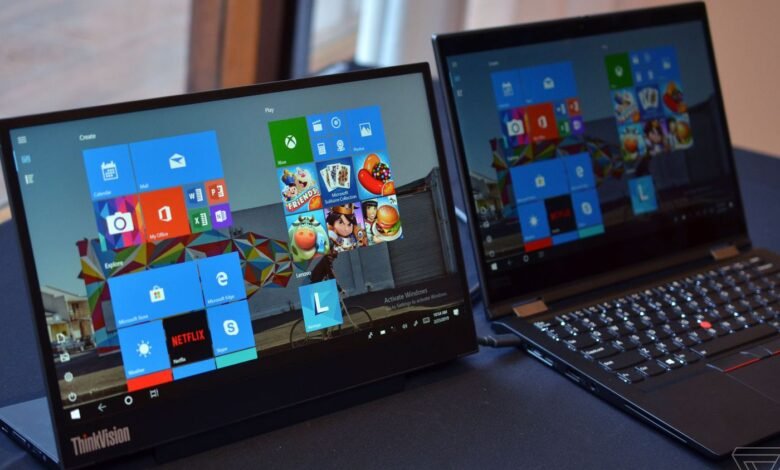9 Must-Have Features for Your Next Portable Laptop Monitor
Let’s dive in, and we'll break down the top 9 features you'll want to consider as you shop for your next portable laptop monitor.

Have you found yourself in situations where your laptop’s screen just isn’t cutting it? Whether you’re working from home, traveling for work, or just want a bigger screen for entertainment on the go, a portable laptop monitor can be a game-changer.
With so many of the best portable monitors for laptops on the market nowadays, it can be tough to figure out which features are really must-haves versus nice-to-haves.
Let’s dive in, and we’ll break down the top 9 features you’ll want to consider as you shop for your next portable laptop monitor.
1. Display Size and Resolution
The display size and resolution are going to be two of the most important factors to consider upfront.
- For basic productivity tasks, a 15-inch display may suffice, while content creation benefits from more screen real estate at 17 inches or larger. Consider how much multitasking you’ll be doing.
- Resolution impacts visual clarity and quality. Full HD 1080p (1920×1080) should be your minimum for sharp images and text. This resolution allows you to spread out windows and view documents and spreadsheets side by side comfortably.
- Higher 2K (2560×1440) and 4K (3840×2160) resolutions are worthwhile if you work with graphics-heavy files like images, video, or CAD designs on your portable monitor. The increased pixel density provides a noticeable boost in on-screen detail for these types of work.
- 4K resolution pushes the limits of what’s practical at smaller screen sizes, though, so weigh your needs carefully. 4K may be overkill for 15-inch displays, but it is very useful at 17 inches or more when you can appreciate the extra pixels.
- Consider screen size versus resolution when factoring in file sizes, too. 4K resolution files can cause laptops with limited storage space some issues, depending on your specific workflow.
2. Screen Ratio
The screen ratio, or aspect ratio, refers to the width and height of the display. Most laptops use a 16:9 widescreen ratio, so you’ll want your best portable monitor for a laptop to match that ratio to avoid any awkward scaling issues when extending your laptop display. Some models do offer alternative ratios like 3:2 or 4:3 if you need something different, but 16:9 is the safest bet for compatibility with your laptop.
3. Portability
When it comes to portable monitors, portability is obviously a major factor. Look for a monitor that is lightweight, compact when folded up or packed away, and has an integrated carrying case or sleeve for easy transportation.
Pay attention to the weight; under 3 pounds is ideal for true portability. The stand should fold flat for storage and swivel or tilt for ergonomic viewing angles. Battery life is also important; the best travel monitors offer 3–4 hours, but longer battery life means less downtime when you’re on the go.
4. Connectivity
You’ll need a portable monitor that connects easily to your laptop. HDMI is the most common option, allowing for video and audio transfer, but some include additional ports like USB-C, DisplayPort, or Mini DisplayPort for maximum compatibility.
WiFi connectivity is also a nice bonus, eliminating the need for a physical connection. Consider your laptop’s ports when choosing the best travel monitor to ensure a seamless connection. Look for a monitor that can connect to multiple devices simultaneously via multiple ports or screen mirroring as well.
5. Touchscreen
While not an absolute necessity, a touchscreen can enhance productivity and usability on a portable monitor. This is especially useful if you use your fingers to navigate instead of a mouse or trackpad.
Touch capability allows you to scroll, swipe, tap and more directly on the screen. It also opens up the possibility of using the best portable monitors with touch-enabled devices beyond just your laptop, like tablets or phones. If your work involves graphics design, digital art, or other touch-friendly tasks, a touchscreen portable monitor provides more flexibility.
6. Adjustability
An adjustable stand is important for ergonomic viewing on a portable monitor. It should tilt, swivel, and rotate the screen for comfortable viewing from different angles and positions. Full motion is ideal to get the screen positioned exactly how you need it. The stand should also fold flat for storage and have multiple height settings to accommodate different surface levels when traveling or working from different areas around your home. This adjustability allows for a healthier work setup, no matter where you set up your portable workspace.
7. Special Features
Some large portable monitors take things a step further with unique features beyond the basics. Look for extras like integrated speakers to eliminate the need for separate audio, built-in batteries to cut the cord from your laptop entirely for truly portable use, or a built-in cover or case that doubles as a stand to reduce bulk when traveling.
Special touches like ambient light sensors that automatically adjust brightness based on your environment or blue light filters for eye comfort are nice bonuses too. These sorts of special features elevate your portable monitor beyond just the screen.
8. Software
Advanced software can enhance the functionality of your portable monitor.
- Look for options with built-in software for mirroring or extending your laptop display, adjusting brightness and colors, applying screen filters, and more.
- Being able to control your monitor display and settings from an app adds convenience.
- Some monitors even offer software that allows you to use the monitor as a second screen wirelessly for your smartphone or tablet in addition to your laptop.
- Well-designed software makes the most of your portable monitor’s capabilities.
9. Warranty and Support
Consider the warranty coverage and support offered when choosing a portable monitor. You want the security of at least a 1-year manufacturer’s warranty on parts and labor in case anything goes wrong early on.
Some companies offer even longer (2–3 years) warranties for added protection on your investment. Support options like online help articles, customer service phone and email, replacement programs, and authorized retailers provide peace of mind if issues arise down the road. Backing from the manufacturer shows confidence and reliability.
Final Words
Choosing the right portable laptop monitor takes some research, but focusing on these top 10 must-have features will help you select a high-quality option that perfectly complements your laptop for versatile, on-the-go productivity and entertainment. Consider your needs, priorities for portability versus size, and compatibility with your laptop when shopping monitors. With the right feature-packed portable monitor, you’ll wonder how you ever lived without its screen real estate and versatility.



